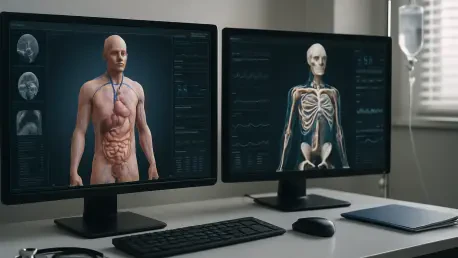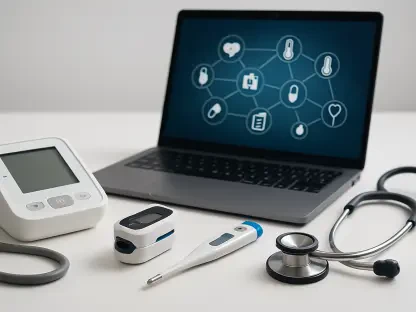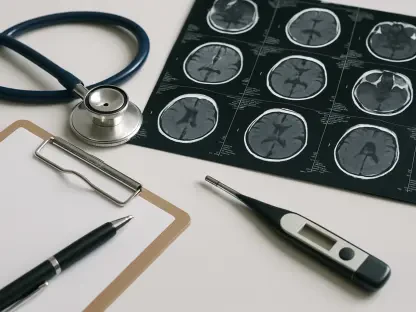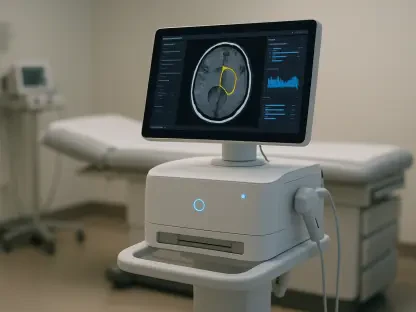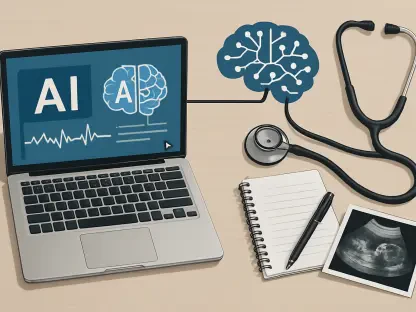Picture a world where medical care isn’t just a response to illness but a carefully crafted prediction of health needs, uniquely designed for each person based on their specific biological and lifestyle data. Digital twins, sophisticated virtual replicas of patients, medical devices, or entire healthcare systems, are poised to redefine the medical field in the coming years. With the global healthcare digital twin market already valued at $2.1 billion in 2024 and expected to surge at an impressive annual growth rate of 27% through the end of the decade, this technology is capturing attention across the industry. By harnessing real-time data alongside artificial intelligence (AI), digital twins offer the potential to tailor treatments with unprecedented precision, enhance operational efficiencies in healthcare settings, and drive groundbreaking innovations in medical research. This transformative approach is not a distant dream but a rapidly approaching reality that could reshape how health and well-being are managed on a global scale.
Tailoring Treatments Through Personalization
Digital twins are emerging as a cornerstone of personalized medicine, fundamentally changing how treatments are developed and delivered. These virtual models replicate individual patient profiles by integrating data from diverse sources such as electronic health records, wearable technology, and genomic sequencing. This allows healthcare providers to simulate potential disease trajectories and evaluate how a patient might respond to various interventions, whether it’s a specific medication or a complex surgical procedure. The result is a significant reduction in the traditional trial-and-error method, minimizing risks like adverse reactions while maximizing therapeutic effectiveness. As a tool for precision, digital twins empower clinicians to craft bespoke care plans that align closely with each patient’s unique needs, marking a shift from generic protocols to highly individualized healthcare strategies that promise better outcomes.
Beyond individual treatment plans, the scope of digital twins extends to proactive health management, addressing some of the most persistent challenges in medicine today. They facilitate early detection of potential health issues by continuously monitoring real-time data and identifying subtle changes that might indicate the onset of disease. For those with chronic conditions, such as diabetes or heart disease, these virtual replicas can predict flare-ups or complications, enabling timely interventions that prevent hospitalizations. Remote monitoring capabilities further enhance accessibility, allowing patients in underserved areas to receive high-quality care without frequent in-person visits. This technology not only improves patient experiences but also alleviates pressure on healthcare systems by reducing unnecessary procedures and optimizing resource use, setting a new standard for what proactive, patient-centered care can achieve.
Accelerating Innovation in Drug Development
Digital twins are revolutionizing the pharmaceutical sector by streamlining the arduous process of drug discovery and development. By creating virtual simulations of human biology, these models allow researchers to test how new compounds interact with the body long before they enter clinical trials. This predictive capability helps identify the most promising drug candidates early on, while also flagging potential side effects or toxicities that might otherwise go unnoticed until later stages. Incorporating AI and vast datasets from real-world patient information, digital twins enable pharmaceutical companies to refine formulations with greater accuracy, significantly cutting down both the time and financial investment required to bring new therapies to market, ultimately benefiting patients who need faster access to innovative treatments.
The impact of digital twins on clinical trials represents another leap forward in pharmaceutical efficiency. Traditional trials often span years and involve substantial costs, with no guarantee of success due to unforeseen patient responses. Digital twins mitigate these risks by simulating trial outcomes across diverse virtual patient populations, providing insights into efficacy and safety profiles before human testing begins. This approach not only boosts trial success rates but also reduces reliance on extensive physical testing phases, aligning with regulatory goals to expedite approvals for critical medications. As adoption grows, the technology is set to transform the industry into a more agile and data-driven field, ensuring that life-saving drugs reach those in need without the delays that have historically plagued the development pipeline.
Optimizing Healthcare Systems and Operations
Healthcare facilities are under constant strain to deliver quality care amidst limited resources, and digital twins offer a powerful solution to enhance operational efficiency. By simulating hospital workflows, these virtual models can predict patient volumes, optimize staff scheduling, and ensure equipment availability during peak times or emergencies. This capability allows administrators to anticipate bottlenecks before they occur, such as delays in emergency departments or shortages of critical supplies, thereby improving patient flow and reducing wait times. In an era where healthcare systems face unprecedented demand, digital twins provide a strategic tool to maximize existing infrastructure, ensuring that resources are allocated where they are most needed without wasteful expenditure or unnecessary downtime.
Government support and increased investments are further accelerating the integration of digital twins into healthcare operations. Many regions are recognizing the potential of this technology to address systemic inefficiencies and are rolling out policies and funding to encourage adoption. For instance, simulating asset management through digital twins can extend the lifespan of expensive medical equipment by predicting maintenance needs, while virtual models of entire facilities can guide expansions or renovations with data-driven precision. This alignment of technology with policy creates a fertile ground for innovation, enabling hospitals and clinics to modernize in ways that directly improve access to care. As these virtual tools become more embedded in daily operations, they promise to build more resilient healthcare systems capable of adapting to future challenges with agility and foresight.
Harnessing Technology for Scalable Solutions
The meteoric rise of digital twins in healthcare is deeply tied to parallel advancements in supporting technologies like the Internet of Things (IoT), cloud computing, and big data analytics. IoT devices, such as smart wearables and sensors, continuously feed real-time health data into digital twin models, ensuring they remain dynamic and reflective of a patient’s current state. Cloud platforms provide the necessary infrastructure to store and process these massive datasets, making it possible to scale digital twins across large populations or complex systems without performance lags. This technological synergy ensures that virtual replicas are not just theoretical constructs but practical tools that can be deployed in diverse settings, from small clinics to sprawling hospital networks, enhancing their utility and reach.
Artificial intelligence and machine learning add another layer of sophistication to digital twins, sharpening their predictive and analytical capabilities. These technologies enable the models to learn from incoming data, refining simulations over time to offer increasingly accurate insights. For example, AI can analyze patterns in patient data to forecast potential health crises with remarkable precision, while machine learning algorithms adapt to new information, ensuring the digital twin evolves alongside the patient or system it represents. This continuous improvement is critical for maintaining relevance in a fast-changing medical landscape, where new treatments and challenges emerge regularly. As these technologies advance, they will further solidify digital twins as indispensable assets in delivering data-driven, future-ready healthcare solutions.
Expanding Global Reach and Market Dynamics
The healthcare digital twin market is experiencing robust growth, with distinct regional dynamics shaping its trajectory toward 2030. North America currently leads due to its well-established healthcare infrastructure and early embrace of cutting-edge technologies, fostering an environment ripe for innovation. Meanwhile, the Asia Pacific region is emerging as a hotbed of opportunity, driven by substantial investments in countries like China and India, where healthcare modernization is a priority. This global disparity highlights the varying paces of adoption but also underscores a universal trend: the demand for digital twins spans software platforms, consulting services, and applications ranging from surgical planning to medical device testing, reflecting a broad spectrum of needs that this technology can address.
Competitive forces are also propelling the market forward, as major technology and healthcare companies vie for dominance. Industry leaders such as IBM, Microsoft, and Siemens are investing heavily in research and development, forging strategic partnerships with medical institutions to integrate digital twins into clinical and operational frameworks. These collaborations often extend to geographic expansion, targeting high-growth areas to tap into unmet demand. Such efforts ensure that digital twins are not confined to niche applications but are becoming mainstream tools across the healthcare spectrum. As the market continues to evolve, this competitive energy will likely drive further innovation, making digital twins accessible to a wider array of stakeholders and cementing their role in shaping the future of global health.
Shaping a Data-Driven Healthcare Legacy
Reflecting on the journey so far, digital twins have already begun to leave an indelible mark on healthcare by integrating vast streams of data into actionable virtual models that enhance decision-making. Their ability to personalize treatments, streamline drug development, and optimize hospital operations has proven transformative, addressing long-standing inefficiencies with precision and foresight. Supported by technological advancements and strategic industry partnerships, the adoption of this technology has gained momentum, setting a foundation for even greater impact. Moving forward, the focus should shift to overcoming barriers like data privacy concerns and high implementation costs through robust standards and collaborative efforts. By prioritizing interoperability and accessibility, stakeholders can ensure that digital twins continue to evolve, ultimately building a healthcare ecosystem where predictive, personalized care becomes the norm rather than the exception.
